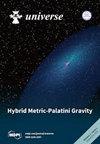K± 介子中的 cos 2ϕh 不对称和电子离子对撞机上的Λ-氙产生的 SIDIS 过程
IF 2.6
4区 物理与天体物理
Q2 ASTRONOMY & ASTROPHYSICS
引用次数: 0
摘要
我们研究了K±和Λ质子产生的SIDIS过程中布尔-穆尔德斯函数和柯林斯函数耦合产生的cos2jh方位角不对称。通过考虑利用非微扰苏达科夫形式因子参数化的 TMD 演化效应,在前沿阶横向动量依赖(TMD)因式分解框架下研究了这种不对称现象。通过引入近似演化核,考虑了终态强子柯林斯函数的对偶演化效应的 DGLAP 演化效应。我们利用质子布尔-穆尔德斯函数和 K± 的柯林斯函数的现有参数化。对于Λ超子的柯林斯函数,由于没有参数化,我们采用了二夸克旁观者模型的结果。在 EIC 和 EicC 运动学区域得到了 cos2ϕh 方位角不对称的数值结果。结果表明,这种不对称比 Sivers 不对称小得多,这意味着 Boer-Mulders 函数和 Collins 函数的卷积可能不是 cos2jh 不对称的主要原因。我们强调未来测量 cos2ϕh 不对称的重要性,以揭示不同的贡献者。本文章由计算机程序翻译,如有差异,请以英文原文为准。
The cos 2ϕh Asymmetry in K± Mesons and the Λ-Hyperon-Produced SIDIS Process at Electron Ion Colliders
We investigate the cos2ϕh azimuthal asymmetry contributed by the coupling of the Boer–Mulders function and the Collins function in K±- and Λ-hyperon-produced SIDIS process. The asymmetry is studied under the transverse-momentum-dependent (TMD) factorization framework at the leading order by considering the TMD evolution effects that utilize the parametrization for non-perturbative Sudakov form factors. The DGLAP evolution effects of the collinear counterpart of the Collins function of the final-state hadrons are considered by introducing the approximated evolution kernels. We utilize the available parametrization for the proton Boer–Mulders function and the Collins function of K±. For the Collins function of the Λ hyperon, the result of the diquark spectator model is adopted due to the absence of parametrization. The numerical results of the cos2ϕh azimuthal asymmetry are obtained in the kinematic regions of EIC and EicC. It can be shown that the asymmetry is much smaller than the Sivers asymmetry, which means that the convolution of the Boer–Mulders function and the Collins function may not be the main contributor to the cos2ϕh asymmetry. We emphasize the importance of future measurement of the cos2ϕh asymmetry to unravel different contributors.
求助全文
通过发布文献求助,成功后即可免费获取论文全文。
去求助
来源期刊

Universe
Physics and Astronomy-General Physics and Astronomy
CiteScore
4.30
自引率
17.20%
发文量
562
审稿时长
24.38 days
期刊介绍:
Universe (ISSN 2218-1997) is an international peer-reviewed open access journal focused on fundamental principles in physics. It publishes reviews, research papers, communications, conference reports and short notes. Our aim is to encourage scientists to publish their research results in as much detail as possible. There is no restriction on the length of the papers.
 求助内容:
求助内容: 应助结果提醒方式:
应助结果提醒方式:


